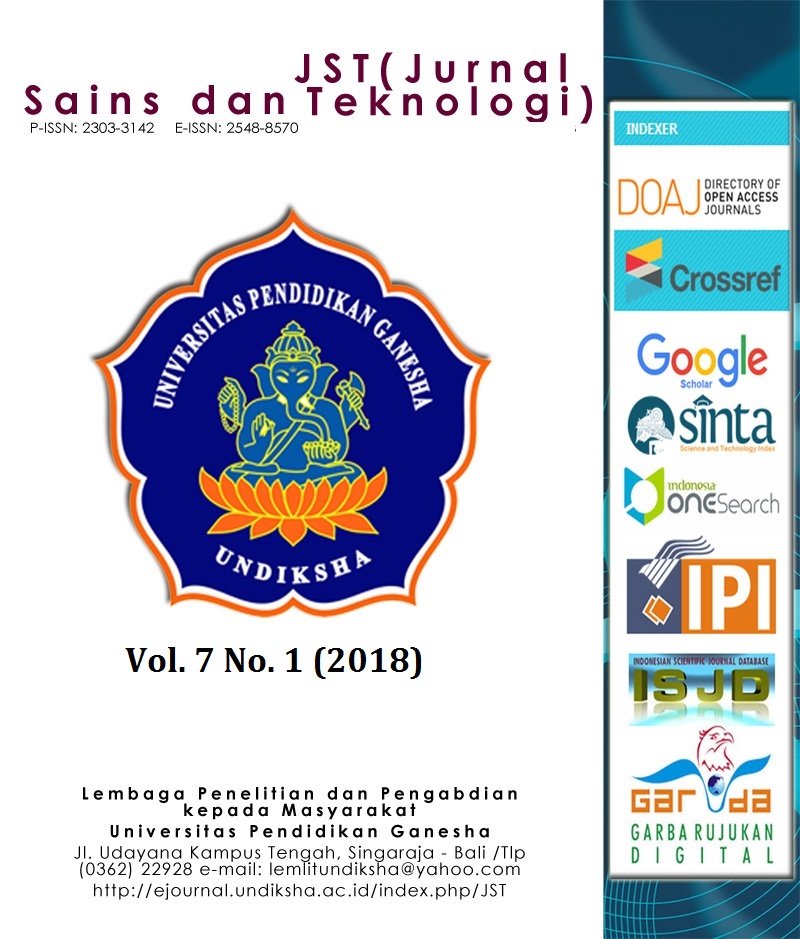Identifikasi Iris dengan Snake Model-PSO dan Gabor 2-D
DOI:
https://doi.org/10.23887/jstundiksha.v7i1.13010Keywords:
Iris, Snake Model-PSO, Gabor 2-D, FMR, FNMRAbstract
Pada penelitian ini dibangun sistem identifikasi biometrik iris dengan menggunakan metode Snake Model-PSO dan Gabor 2-D. Tahap-tahap yang dilakukan pada penelitian ini terdiri dari akuisisi citra, pre-processing, segmentasi, ekstraksi ciri, dan pengenalan. Metode Snake Model-PSO diterapkan dengan memanfaatkan koordinat titik pusat pupil yang telah ditemukan sebelumnya. Proses ekstraksi ciri dilakukan dengan menggunakan tapis Gabor 2-D berukuran 33×33 dan sudut orientasi bernilai 90º, 45º, 0º, dan -45º. Jumlah data referensi yang digunakan sebanyak 117 citra iris. Jumlah data uji yang digunakan sebanyak 78 citra iris. Berdasarkan hasil pengujian dapat disimpulkan bahwa persentase FMR sebesar 3,6737% dan FNMR sebesar 4,2735% untuk database iris kiri. Persentase FMR dan FNMR untuk database iris kanan menghasilkan yang sama, yakni 0%. Unjuk kerja sistem berdasarkan akurasi keputusan menghasilkan persentase terbaik sebesar 91, 0256% untuk database iris kiri dan 98,7179% untuk database iris kanan. Rata-rata waktu proses pada pendaftaran adalah 6,3109 detik, sedangkan pada identifikasi adalah 20,494 detik.
Kata kunci: iris, Snake Model-PSO, Gabor 2-D, FMR, FNMR
References
Choudhary, D., Singh, A. K., & Tiwari, S. (2013). A Statistical Approach for Iris Recognition Using K-NN Classifier. International Journal of Image, Graphics and Signal Processing, 5(4), 46–52. https://doi.org/10.5815/ijigsp.2013.04.06
Kaur, A., & Singh, M. D. (2012). An Overview of PSO- Based Approaches in Image Segmentation. International Journal of Engineering and Technology (IJET), 2(8), 1349–1358.
Masek, L. (2003). Recognition of Human Iris Patterns for Biometric Identification. University of Western Australia.
Nixon, M., & Aguado, A. (2008). Feature Extraction & Image Processing (Second Edi). London: Elsevier.
Putra, D. (2010). Pengolahan Citra Digital.
Tang, R., Han, J., & Zhang, X. (2009). Efficient iris segmentation method with support vector domain description. Optica Applicata, 39(2), 365–374.
Downloads
Published
How to Cite
Issue
Section
License
Authors who publish with the Jurnal Sains dan Teknologi (JST) agree to the following terms:
- Authors retain copyright and grant the journal the right of first publication with the work simultaneously licensed under a Creative Commons Attribution License (CC BY-SA 4.0) that allows others to share the work with an acknowledgment of the work's authorship and initial publication in this journal.
- Authors are able to enter into separate, additional contractual arrangements for the non-exclusive distribution of the journal's published version of the work (e.g., post it to an institutional repository or publish it in a book), with an acknowledgment of its initial publication in this journal.
- Authors are permitted and encouraged to post their work online (e.g., in institutional repositories or on their website) prior to and during the submission process, as it can lead to productive exchanges, as well as earlier and greater citation of published work. (See The Effect of Open Access)
















